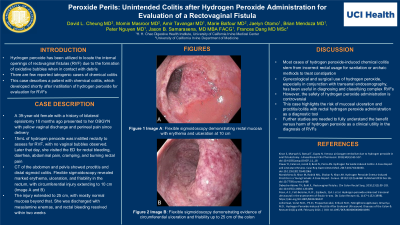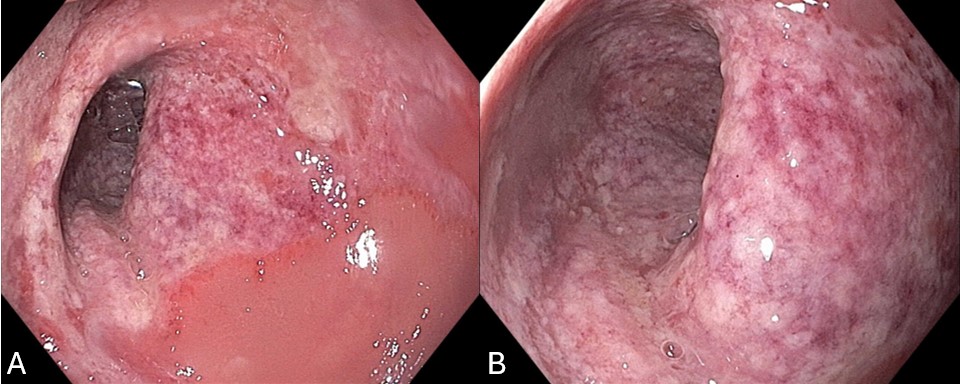Monday Poster Session
Category: Colon
P2075 - Peroxide Perils: Unintended Colitis After Hydrogen Peroxide Administration for Vvaluation of a Rectovaginal Fistula
Monday, October 28, 2024
10:30 AM - 4:00 PM ET
Location: Exhibit Hall E

Has Audio
- DC
David L. Cheung, MD
University of California, Irvine
Orange, CA
Presenting Author(s)
David L. Cheung, MD, Momin Masroor, MD, Amirali Tavangar, MD, Marie Balfour, MD, Jaelyn Otomo, BS, Brian Mendoza, MD, Peter H. Nguyen, MD, Jason Samarasena, MD, Frances Dang, MD
University of California, Irvine, Orange, CA
Introduction: Hydrogen peroxide has been utilized to locate the internal openings of rectovaginal fistulas (RVF) due to the formation of oxidative bubbles when in contact with debris. Most cases of hydrogen peroxide-induced chemical colitis stem from incorrect rectal usage for sanitation or archaic methods to treat constipation. There are few reported iatrogenic cases of chemical colitis. This case describes a patient with chemical colitis, which developed shortly after instillation of hydrogen peroxide for evaluation for RVFs.
Case Description/Methods: A 39-year-old female with a history of bilateral episiotomy after vaginal delivery 10 months prior presented to her OBGYN appointment with complaints of yellow vaginal discharge and perineal pain since her delivery. The patient had hydrogen peroxide instilled into the rectum to assess for RVF. No bubbles were noted in the vagina after administration of hydrogen peroxide. On the same day of her appointment, she went to the emergency department for rectal bleeding with associated diarrhea, abdominal pain, cramping, and burning rectal pain. CT of the abdomen and pelvis demonstrated proctitis and distal sigmoid colitis. Flexible sigmoidoscopy revealed significant erythema and ulceration in the immediate rectum, with circumferential injury and ulceration and friability without necrosis at 10 cm (Image A and B). The injury extended to about 25 cm after which there was mostly normal mucosa. She was discharged with mesalamine enemas and noted resolution in rectal bleeding within two weeks.
Discussion: Gynecological and surgical use of hydrogen peroxide, especially in conjunction with transanal endosonography, has been useful in diagnosing and classifying complex RVFs. However, the safety of hydrogen peroxide administration is controversial. This case highlights the risk of mucosal ulceration and proctitis/colitis with rectal hydrogen peroxide administration as a diagnostic tool. Further studies are needed to fully understand the benefit versus harm of hydrogen peroxide as a clinical utility in the diagnosis of RVFs.

Disclosures:
David L. Cheung, MD, Momin Masroor, MD, Amirali Tavangar, MD, Marie Balfour, MD, Jaelyn Otomo, BS, Brian Mendoza, MD, Peter H. Nguyen, MD, Jason Samarasena, MD, Frances Dang, MD. P2075 - Peroxide Perils: Unintended Colitis After Hydrogen Peroxide Administration for Vvaluation of a Rectovaginal Fistula, ACG 2024 Annual Scientific Meeting Abstracts. Philadelphia, PA: American College of Gastroenterology.
University of California, Irvine, Orange, CA
Introduction: Hydrogen peroxide has been utilized to locate the internal openings of rectovaginal fistulas (RVF) due to the formation of oxidative bubbles when in contact with debris. Most cases of hydrogen peroxide-induced chemical colitis stem from incorrect rectal usage for sanitation or archaic methods to treat constipation. There are few reported iatrogenic cases of chemical colitis. This case describes a patient with chemical colitis, which developed shortly after instillation of hydrogen peroxide for evaluation for RVFs.
Case Description/Methods: A 39-year-old female with a history of bilateral episiotomy after vaginal delivery 10 months prior presented to her OBGYN appointment with complaints of yellow vaginal discharge and perineal pain since her delivery. The patient had hydrogen peroxide instilled into the rectum to assess for RVF. No bubbles were noted in the vagina after administration of hydrogen peroxide. On the same day of her appointment, she went to the emergency department for rectal bleeding with associated diarrhea, abdominal pain, cramping, and burning rectal pain. CT of the abdomen and pelvis demonstrated proctitis and distal sigmoid colitis. Flexible sigmoidoscopy revealed significant erythema and ulceration in the immediate rectum, with circumferential injury and ulceration and friability without necrosis at 10 cm (Image A and B). The injury extended to about 25 cm after which there was mostly normal mucosa. She was discharged with mesalamine enemas and noted resolution in rectal bleeding within two weeks.
Discussion: Gynecological and surgical use of hydrogen peroxide, especially in conjunction with transanal endosonography, has been useful in diagnosing and classifying complex RVFs. However, the safety of hydrogen peroxide administration is controversial. This case highlights the risk of mucosal ulceration and proctitis/colitis with rectal hydrogen peroxide administration as a diagnostic tool. Further studies are needed to fully understand the benefit versus harm of hydrogen peroxide as a clinical utility in the diagnosis of RVFs.

Figure: Figure 1: Image A: Rectal mucosa with erythema and ulceration at 10 cm. Image B: Evidence of circumferential ulceration and friability up to 25 cm of the colon
Disclosures:
David Cheung indicated no relevant financial relationships.
Momin Masroor indicated no relevant financial relationships.
Amirali Tavangar indicated no relevant financial relationships.
Marie Balfour indicated no relevant financial relationships.
Jaelyn Otomo indicated no relevant financial relationships.
Brian Mendoza indicated no relevant financial relationships.
Peter Nguyen indicated no relevant financial relationships.
Jason Samarasena: Cook Medical – Consultant. Medtronic – Advisory Committee/Board Member, Consultant. Neptune Medical – Advisory Committee/Board Member, Consultant. Olympus – Advisory Committee/Board Member, Consultant. Ovesco – Advisory Committee/Board Member, Consultant, Speakers Bureau. SatisfAI – Stock-privately held company. Steris – Advisory Committee/Board Member.
Frances Dang indicated no relevant financial relationships.
David L. Cheung, MD, Momin Masroor, MD, Amirali Tavangar, MD, Marie Balfour, MD, Jaelyn Otomo, BS, Brian Mendoza, MD, Peter H. Nguyen, MD, Jason Samarasena, MD, Frances Dang, MD. P2075 - Peroxide Perils: Unintended Colitis After Hydrogen Peroxide Administration for Vvaluation of a Rectovaginal Fistula, ACG 2024 Annual Scientific Meeting Abstracts. Philadelphia, PA: American College of Gastroenterology.

